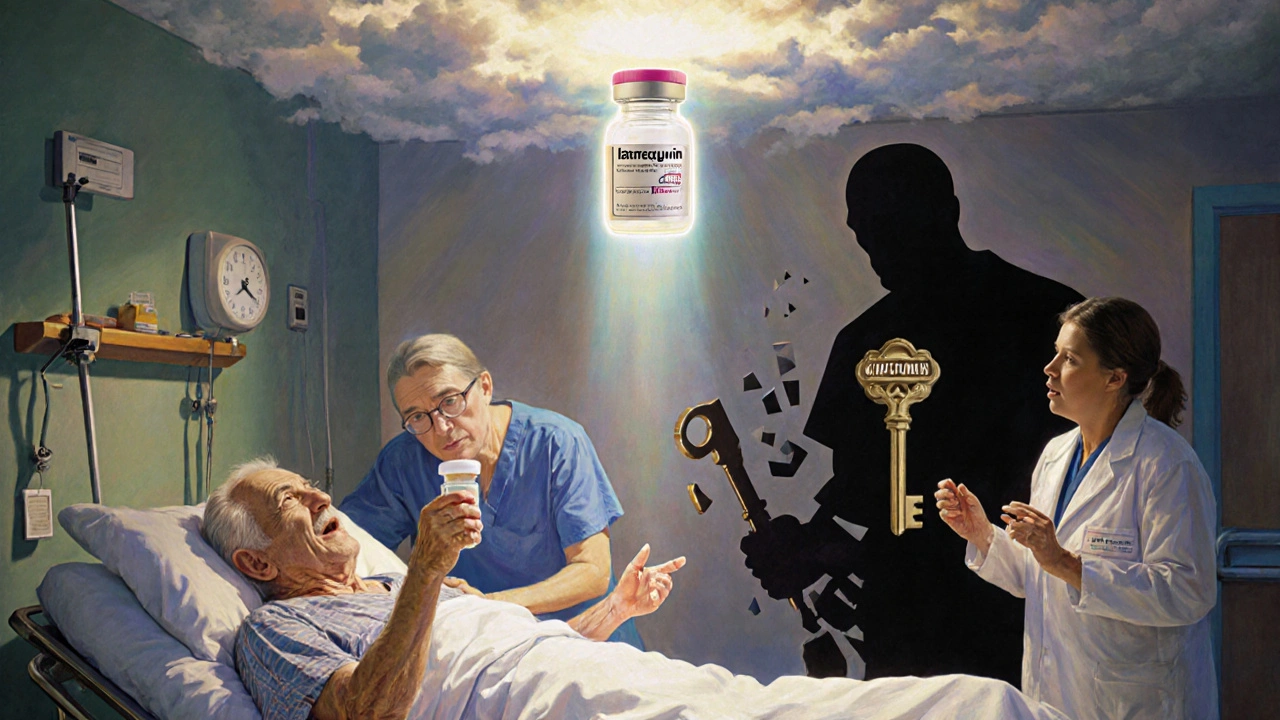Bleeding Risk Calculator
Personal Risk Assessment
Enter your health information to see how different blood thinners compare for your specific situation.
Your Personalized Risk Assessment
Total Risk Score
0
(0-5 = Low, 3-5 = High)
Recommendation
Comparative Bleeding Risk
| Medication | Major Bleeding Risk (per 100 person-years) | Brain Bleeding Risk |
|---|---|---|
| Warfarin | 0.0 | 0.0 |
| Apixaban | 0.0 | 0.0 |
| Rivaroxaban | 0.0 | 0.0 |
| Dabigatran | 0.0 | 0.0 |
Important Contraindications
When you need a blood thinner, the choice isn’t just about stopping clots-it’s about living without constant worry. For decades, warfarin was the only option. Now, a newer group of drugs called Direct Oral Anticoagulants (DOACs) has taken over as the go-to for most people. But which one is safer? Which causes fewer bleeds? And why do some patients still end up on warfarin despite the hype?
How DOACs and Warfarin Work Differently
Warfarin has been around since the 1950s. It works by blocking vitamin K, which your body needs to make clotting proteins. That means what you eat-especially leafy greens like spinach or kale-can throw your dose off. One bowl of kale can drop your INR (a blood test that measures clotting time) from 2.5 to 1.8 in under two days. That’s not rare. It’s normal.
DOACs like apixaban (Eliquis), rivaroxaban (Xarelto), dabigatran (Pradaxa), and edoxaban (Savaysa) work differently. They target specific clotting factors directly-either factor Xa or thrombin. No vitamin K interference. No weekly blood tests. No guessing if your salad ruined your dose.
This isn’t just convenience. It’s safety. Studies show DOACs cut the risk of major bleeding by about 30% compared to warfarin. And that’s not a small win. Major bleeding means hospitalization, transfusions, or even death. The biggest drop? Intra-cranial bleeding-bleeding in the brain. DOACs reduce that risk by 50-60%. For older adults, that’s life-changing.
Bleeding Risks: The Real Difference
Not all DOACs are created equal when it comes to bleeding. Apixaban consistently comes out on top. In a 2025 JACC study tracking over 10,000 patients, apixaban had the lowest bleeding rate at 1.9 events per 100 person-years. Warfarin? 2.4. Rivaroxaban? 2.8. That’s higher than warfarin.
Why does this matter? Because if you’re over 80, have kidney issues, or have had a stomach bleed before, the wrong DOAC can be dangerous. Doctors now use a simple 5-point scoring system to pick the safest option: age over 75, kidney problems, past bleeding, taking aspirin or NSAIDs, and being female. If you score 3 or higher, apixaban is the clear recommendation.
Warfarin’s bleeding risk isn’t just about the drug-it’s about how hard it is to control. If your INR is out of range more than 40% of the time (which happens in many clinics), your bleeding risk shoots up. Centers with poor INR control have bleeding rates worse than DOACs. That’s not the drug’s fault-it’s the system.
Who Still Needs Warfarin?
DOACs aren’t perfect for everyone. If you have a mechanical heart valve, DOACs are off-limits. The FDA explicitly warns against them here. Warfarin is the only approved option. Same goes for people with antiphospholipid syndrome-a condition that causes dangerous clots. Studies show DOACs increase the risk of clots by nearly three times in these patients compared to warfarin.
Severe kidney disease is another red flag. Most DOACs need dose adjustments if your kidney function drops below 30 mL/min. If it’s below 15, they’re often not safe at all. Warfarin doesn’t care about your kidneys. It’s still usable.
And then there’s cost. Warfarin costs $4 to $10 a month. DOACs? $450 to $600 without insurance. Even with Medicare, copays can hit $30-$100. That’s a huge burden for fixed-income seniors. In online patient forums, 63% of people on DOACs say cost is a major stressor. Only 22% of warfarin users say the same.

Monitoring, Diet, and Daily Life
Warfarin demands constant attention. You need INR checks every week or two. You can’t suddenly eat a huge plate of broccoli without calling your doctor. You can’t take ibuprofen for your back pain without risking a bleed. Over 70% of warfarin users report frustration with these restrictions.
DOACs? Take them once or twice a day. No diet changes. No blood tests. No drug interaction nightmares. A 2023 survey of 1,247 patients found 78% of DOAC users said their quality of life improved. Only 42% of warfarin users said the same.
But here’s the catch: DOACs have a short half-life. If you miss a dose, the drug leaves your system fast. Rivaroxaban is gone in 12 hours. That means skipping a pill-even once-can leave you unprotected. Warfarin sticks around for days. You can miss a dose and still be covered. That’s why adherence matters more with DOACs. One study found 28% of warfarin users stopped taking it within a year. For DOACs? Only 18%.
Reversing the Blood Thinner: What Happens in an Emergency?
If you have a serious bleed or need emergency surgery, how fast can you reverse the drug?
Warfarin can be reversed with vitamin K (takes hours to days) or a concentrated clotting factor product called PCC (works in minutes). It’s not perfect, but it’s reliable.
DOACs have specific antidotes-but only for some. Idarucizumab reverses dabigatran. Andexanet alfa reverses apixaban, rivaroxaban, and edoxaban. These are expensive, hard to get, and not always available in small hospitals. If you’re on a DOAC without an antidote (like edoxaban in some regions), you’re stuck with supportive care: blood transfusions, pressure, time.
That’s why doctors still weigh the odds. For a 90-year-old with a history of falls, the lack of a fast reversal agent might make warfarin the safer bet-even with its other risks.

What Doctors Really Recommend Today
Guidelines from the American Heart Association, the American College of Chest Physicians, and the American College of Cardiology all say: for most people, DOACs are better. Strong recommendation. Grade 1B. That’s the highest level of evidence.
But they also say: choose wisely. Apixaban is the safest overall, especially for older adults, those with kidney issues, or a history of bleeding. Rivaroxaban should be avoided if you’ve had stomach ulcers or GI bleeding. Dabigatran carries a slightly higher risk of stomach upset.
And if you’re on both a DOAC and an NSAID like ibuprofen? You’re doubling your risk of a GI bleed. The FDA added this warning in January 2024. It’s not theoretical. It’s real. One study showed a 2.15-fold increase in bleeding when DOACs and NSAIDs are combined.
The Future: Cheaper DOACs and Better Tools
DOACs aren’t going anywhere. They already make up 75% of new prescriptions. By 2030, that could hit 85%. Why? Because generics are coming. Apixaban’s patent expires in 2026. Rivaroxaban’s in 2027. That could slash prices by 80%.
Research is also moving toward personalized dosing. The ELATES trial is testing whether genetic testing (CYP2C9 and VKORC1 genes) can help fine-tune apixaban doses. Right now, everyone gets the same dose. But some people metabolize it faster. Others slower. That could mean fewer bleeds and better outcomes.
And there’s a new reversal agent in the works-ciraparantag. It’s designed to reverse all anticoagulants, including DOACs and warfarin. If it works, it could change emergency care forever.
Bottom Line: Which One Is Right for You?
For most people-especially those with atrial fibrillation or a blood clot-DOACs are the better choice. They’re safer, simpler, and more predictable. Apixaban is the top pick for safety.
But if you have a mechanical heart valve, severe kidney failure, or antiphospholipid syndrome, warfarin is still the only option. And if you can’t afford DOACs, warfarin remains a viable, if inconvenient, alternative.
The goal isn’t just to prevent a stroke or clot. It’s to live without fear. With DOACs, you can eat your spinach. You can take a vacation. You don’t need to schedule a blood test every Monday. But you do need to take your pill every day. And you need to talk to your doctor about your kidneys, your age, your history of bleeding, and your wallet.
This isn’t a one-size-fits-all decision. It’s a personal one. And with the right info, you can make the best choice-for your body, your life, and your peace of mind.
Are DOACs safer than warfarin?
Yes, for most people. DOACs reduce the risk of major bleeding by about 30% compared to warfarin, especially dangerous brain bleeds. Apixaban has the lowest bleeding rate among DOACs. However, safety depends on your health conditions-like kidney function or past bleeding history.
Can I switch from warfarin to a DOAC?
Most people can, but not everyone. If you have a mechanical heart valve, antiphospholipid syndrome, or very poor kidney function, DOACs aren’t safe. Your doctor will check your medical history, kidney function, and bleeding risk before switching. Never switch on your own.
Do I need blood tests with DOACs?
No routine blood tests are needed for DOACs, unlike warfarin. But your doctor will still check your kidney function every 6-12 months because DOACs are cleared by the kidneys. If your kidney function drops, your dose may need to be adjusted.
What if I miss a dose of my DOAC?
If you miss a dose, take it as soon as you remember-unless it’s almost time for your next dose. Never double up. DOACs leave your system quickly, so missing a dose leaves you unprotected. If you’re unsure, call your doctor or pharmacist. For warfarin, missing one dose is less risky because it stays in your body longer.
Can I take NSAIDs like ibuprofen with a DOAC?
No. Combining NSAIDs (ibuprofen, naproxen, aspirin) with DOACs increases your risk of stomach bleeding by more than double. Use acetaminophen (Tylenol) instead for pain. Always check with your doctor before taking any new medication, even over-the-counter ones.
Why is warfarin still used if DOACs are better?
Warfarin is still used for specific cases: mechanical heart valves, antiphospholipid syndrome, and severe kidney failure. It’s also cheaper-$4-$10 a month versus $30-$100 for DOACs with insurance. For people without good coverage, warfarin remains a necessary option.

Joseph Kiser
October 31, 2025 AT 22:30DOACs are a godsend for most people, but let’s be real-this whole ‘apixaban is safest’ thing is getting overhyped. I’ve seen patients on it bleed out because their ER didn’t have andexanet alfa, and the docs were clueless. Warfarin’s a pain, sure, but at least you know how to fix it. Stop treating DOACs like magic bullets-they’re tools, not miracles.
Hazel Wolstenholme
November 2, 2025 AT 16:32How quaint. You speak of ‘safety’ as if it were a quantifiable metric divorced from socioeconomic context. The privileging of DOACs in clinical guidelines reflects not superior pharmacology, but the commodification of healthcare by Big Pharma. Apixaban’s ‘lower bleeding rate’? Calculated under idealized trial conditions. Real-world adherence? Collapses. And let’s not pretend that $600/month is ‘affordable’-it’s a moral indictment of American medicine.
Mike Laska
November 3, 2025 AT 20:00I had a cousin on rivaroxaban who missed a dose and had a stroke while mowing the lawn. No warning. No INR check. Just… gone. And now his wife has to pay $80 a month for a pill that can kill you faster than warfarin if you slip up. I don’t care what the studies say-when your life hangs on remembering to take a pill every day, that’s not convenience. That’s a gamble with your family’s future.
Alexa Apeli
November 3, 2025 AT 22:27Thank you for this incredibly thorough and compassionate breakdown. 🌟 It’s refreshing to see such nuanced, evidence-based discourse in a world saturated with oversimplified health advice. The emphasis on individualized care-considering kidney function, bleeding history, and financial burden-is exactly what modern medicine should prioritize. Keep sharing insights like this. 💙
Eileen Choudhury
November 5, 2025 AT 22:20My aunt in Mumbai switched from warfarin to apixaban last year-cost was a nightmare until we found a generic through a local NGO. She eats her spinach, travels to Goa, and doesn’t need weekly blood tests. But here’s the thing: in India, most doctors still default to warfarin because they don’t trust DOACs without lab monitoring. We need better training, not just cheaper pills. Education matters as much as access.
Zachary Sargent
November 7, 2025 AT 19:28DOACs are just fancy placebo pills for people who don’t want to be responsible. Miss a dose? Oops. Bleed out? Too bad. Warfarin forces you to be accountable. You check your INR, you watch your greens, you don’t take ibuprofen. It’s not hard-it’s called adulting. The fact that we’ve outsourced our health to a pill that vanishes in 12 hours says more about our culture than our medicine.
Melissa Kummer
November 9, 2025 AT 04:18As a nurse who’s managed anticoagulation for over 15 years, I’ve seen the quiet revolution DOACs brought. No more 7 a.m. finger pricks. No more panic when someone eats kale before an appointment. The data is clear: for 80% of patients, DOACs reduce hospitalizations and improve quality of life. But I agree with Joseph-access to reversal agents is a systemic failure. Hospitals need to stock PCC and andexanet. Period.
Pradeep Kumar
November 9, 2025 AT 21:57My dad is 82, has kidney issues, and takes apixaban. He says it’s the first time in 10 years he didn’t feel like a lab rat. 🙏 No more weekly blood tests. He eats his curry with spinach, goes to temple, and doesn’t stress. But yeah, the cost is still a burden. We pay $40/month with insurance-still 3x his pension. Hope generics come soon. 🤞
Andy Ruff
November 11, 2025 AT 13:20Let me tell you something about DOACs-they’re not safer. They’re just more profitable. The pharmaceutical companies spent billions marketing them as ‘revolutionary’ while burying the fact that their reversal agents are expensive, scarce, and often unavailable in rural hospitals. Meanwhile, warfarin has been used for 70 years with a proven safety profile. Who benefits from this switch? Not the patient. Not the hospital. The shareholders. And you’re all drinking the Kool-Aid because you want to believe the hype. Wake up. This isn’t medicine-it’s capitalism with a stethoscope.
Keerthi Kumar
November 13, 2025 AT 09:48Every culture has its own relationship with medicine-here in India, we treat warfarin like a sacred ritual: the INR chart pinned to the wall, the green vegetables measured like spices, the weekly pilgrimage to the clinic. But DOACs? They’re not just drugs-they’re symbols of liberation. A woman in Kerala told me she could finally cook for her grandchildren without fear. No more ‘don’t eat spinach,’ no more ‘don’t walk barefoot.’ For her, apixaban wasn’t a pill-it was dignity. And yes, cost is a barrier… but so is ignorance. We need community health workers-not just cheaper pills-to bridge this gap.